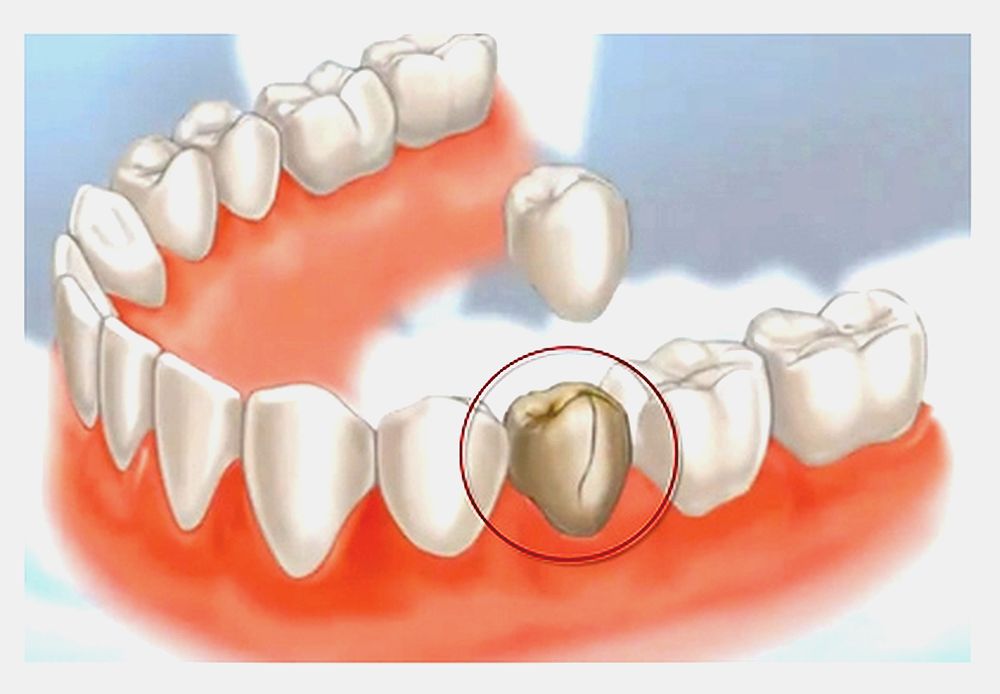Dental crowns are a common and effective way to restore a damaged or decayed tooth. They are typically made of porcelain or metal and are designed to fit over the entire surface of the tooth, providing strength and protection. However, over time, crowns may need to be removed for various reasons, such as damage, decay, or fit issues. If you need to remove a crown from a tooth, it’s important to know the proper steps to do so safely and effectively.

Image: drljubicabanic.com
In this article, we will provide a detailed step-by-step guide on how to remove a crown from a tooth, including both temporary and permanent crowns. We will also discuss the different methods and tools used for crown removal and the importance of seeking professional dental care for the procedure. By following these steps and taking the necessary precautions, you can safely remove a crown from a tooth and maintain good oral health.
Understanding Crown Removal Methods
There are two main methods used to remove a crown from a tooth: mechanical removal and chemical removal. Mechanical removal involves using dental tools to physically loosen and remove the crown, while chemical removal involves dissolving the cement holding the crown in place.
Mechanical Removal
- 1. Safety First: Before attempting to remove a crown, it is crucial to prepare by gathering the necessary tools, ensuring proper lighting and a comfortable working environment.
- 2. Anesthesia: Depending on your tolerance for discomfort, you may opt for local anesthesia to numb the area around the tooth and minimize any pain or discomfort during the procedure.
- 3. Crown Loosening: Using dental tools such as a crown remover or elevator, the dentist gently loosens the crown from the tooth surface. This is achieved by inserting the tool between the crown and the tooth and applying gentle pressure.
- 4. Crown Removal: Once the crown is loosened, it can be carefully lifted off the tooth. In some cases, a dental wedge may be used to assist in separating the crown from the tooth, especially for tightly-fitting crowns.
Chemical Removal
- 1. Preparation: Similar to mechanical removal, preparing the area for chemical removal involves ensuring a safe and comfortable work environment.
- 2. Crown Cement Dissolution: A chemical solvent or crown remover gel is applied to the area around the crown, targeting the cement that holds the crown in place.
- 3. Crown Loosening: The solvent or gel is left for a specific duration to allow it to dissolve the cement. This weakens the bond between the crown and the tooth, making it easier to remove.
- 4. Crown Removal: Once the cement is dissolved, the crown can be gently lifted off the tooth using dental tools, such as an elevator or forceps.
Removing Temporary Crowns
Temporary crowns, also known as provisional crowns, are usually made of acrylic or resin materials and are placed on a prepared tooth for a limited duration, typically until a permanent crown is ready. Removing a temporary crown is generally less complex compared to removing a permanent crown, as the cement used is designed to be weaker for easy removal.
Steps to Remove a Temporary Crown
- 1. Preparation: Ensure a clean and well-lit work environment, gather necessary tools, and consider using a dental mirror for better visibility.
- 2. Floss Removal: Gently slide dental floss between the temporary crown and the tooth’s edge. Move the floss back and forth to loosen the crown.
- 3. Crown Removal: Once the crown is loose, use your fingers or a dental tool, such as an orange stick, to lift the crown off the tooth.
- 4. Clean the Tooth: Remove any remaining cement or debris from the tooth’s surface using a toothbrush and toothpaste or dental floss.
Importance of Professional Crown Removal
While it may be tempting to try removing a crown at home, it is strongly recommended to seek professional dental care for crown removal. Attempting to remove a crown without proper training or tools can lead to complications and further damage to the tooth or surrounding structures.
A dentist possesses the necessary skills, experience, and equipment to safely and effectively remove a crown. They can determine the appropriate method based on the type of crown, the condition of the tooth, and your individual circumstances. Additionally, professional crown removal minimizes the risk of injury to the tooth, gums, or soft tissues.

Image: www.saludvidasana.com
How To Remove Crown From Tooth
Conclusion
Crown removal, whether temporary or permanent, requires proper technique and care to avoid complications. Understanding the different methods, steps involved, and importance of seeking professional dental care is essential for ensuring a safe and successful crown removal procedure. By adhering to these guidelines and consulting a qualified dentist, you can protect your oral health and maintain the integrity of your teeth.
Remember, maintaining good oral hygiene practices, including regular brushing, flossing, and dental checkups, is crucial for overall dental health. If you experience any issues or concerns with your crowns, do not hesitate to reach out to your dentist for timely evaluation and appropriate treatment.